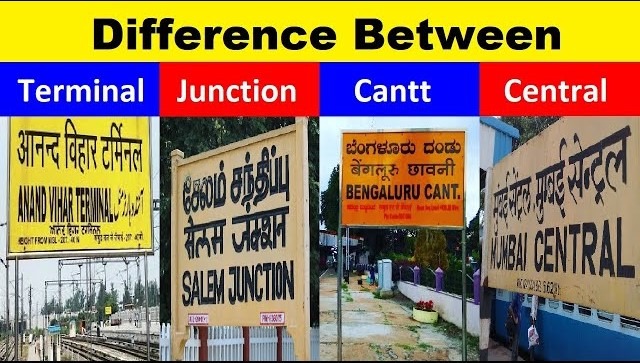The railway network is the backbone of transportation in many countries, offering efficient and cost-effective travel options for millions of passengers daily. Understanding the different types of railway stations can enhance your travel planning and make navigating the railways much easier. This blog explores the three primary types of railway stations: Junction, Terminus, and Central.
Junction Railway Station
A Junction Railway Station is a station where multiple railway lines intersect or diverge. These stations act as critical nodes in the railway network, facilitating the movement of trains and passengers between different routes. Junctions are strategically located to connect various cities, towns, and regions, making them essential for both long-distance and local travel.

Key Features of Junction Stations:
- Multiple Rail Lines: A junction has two or more rail lines branching out in different directions. This setup enables connectivity across diverse regions.
- Transfer Points: Passengers can change trains to reach their destinations efficiently.
- Strategic Importance: Junctions often serve as major hubs for freight and passenger trains, ensuring the smooth operation of the railway system.
Examples of Junction Railway Stations:
- Howrah Junction (HWH): Located in Kolkata, it is one of the busiest railway junctions in India.
- Varanasi Junction (BSB): A pivotal point connecting North and West India.
- Mughalsarai Junction (now Pt. Deen Dayal Upadhyaya Junction): A key junction in Uttar Pradesh that links eastern and northern railway lines.
Terminus Railway Station
A Terminus Railway Station is the end point of a railway line. These stations have tracks that terminate at the platform, meaning trains cannot go further. Terminus stations are often located in metropolitan cities or significant regional centers, serving as starting or ending points for long-distance and suburban trains.
Key Features of Terminus Stations:
- End of the Line: Trains either originate or terminate at these stations.
- High Passenger Volume: Terminus stations handle a large influx of passengers as they serve as critical entry and exit points.
- Extensive Facilities: These stations usually feature comprehensive amenities, such as waiting areas, food courts, and transport connections, to accommodate the high footfall.
Examples of Terminus Railway Stations:
- Chhatrapati Shivaji Maharaj Terminus (CSMT), Mumbai: A UNESCO World Heritage site and one of India’s most iconic railway stations.
- New Delhi Railway Station (NDLS): A key terminus in the capital city, connecting northern India to various regions.
- Chennai Central (MAS): A major terminus in southern India.
Central Railway Station
A Central Railway Station is a primary station located in the heart of a city. While not a technical term, “Central” stations are typically major hubs for passenger trains, offering extensive connectivity and serving as a city’s main railhead. They are often the busiest and most significant stations in the railway network.
Key Features of Central Stations:
- Central Location: These stations are usually located in the downtown area or a city’s main commercial district.
- High Connectivity: Central stations connect to multiple routes, ensuring seamless travel across the network.
- Iconic Architecture: Many Central stations are historic landmarks, known for their architectural grandeur.
Examples of Central Railway Stations:
- Kanpur Central (CNB): One of the busiest railway stations in northern India.
- Thiruvananthapuram Central (TVC): A key station in Kerala.
- Mumbai Central (BCT): A hub for western India’s railway network.
Differences Between Junction, Terminus, and Central Stations
| Feature | Junction Railway Station | Terminus Railway Station | Central Railway Station |
| Definition | Intersecting point for multiple rail lines | End point of a railway line | Main station in a city, offering extensive connectivity |
| Train Movement | Trains diverge or change directions | Trains either originate or terminate | Trains pass through or terminate |
| Location | Located at strategic intersections | Found in cities or regional centers | Centrally located in a city |
| Passenger Traffic | Moderate to High | High | Very High |
| Facilities | Basic to Moderate | Extensive | Extensive |
Also Explore- Nearest Railway Station to Bangalore City & Tourism Places to Visit
Why It’s Important to Know Railway Station Types
Understanding the different Railway Station Types can make your travel more efficient and hassle-free. Knowing whether your destination is a Junction Railway Station, a Terminus Railway Station, or a Central Railway Station helps you plan connections, anticipate facilities, and navigate through the railway network with ease. For example:
- At Junctions: Be prepared to switch platforms for connecting trains.
- At Termini: Arrive early to board long-distance trains, as these stations are often crowded.
- At Central Stations: Expect high passenger traffic and plan your commute accordingly.
The railway system’s complexity is made simpler when you understand its various station types. Whether you’re traveling through a Railway Junction, a Terminus Railway Station, or a Central Railway Station, each type plays a vital role in ensuring the smooth operation of the network. By recognizing these distinctions, you can make your journey more organized and enjoyable.




